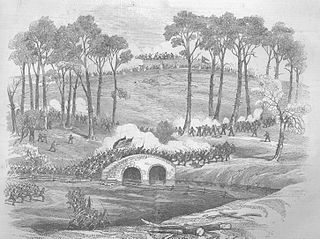
The Battle of Kinston was fought on December 14, 1862, in Lenoir County, North Carolina, near the town of Kinston, as part of the Goldsborough Expedition of the American Civil War.
The 9th New Jersey Infantry Regiment was an American Civil War infantry regiment from New Jersey that served from October 1861 through July 1865 in the Union Army. The regiment got its nickname, Jersey Muskrats, during the Battle of Roanoke Island when they successfully "sloshed through shoe sucking mud into waist deep water in "division" formation", giving the regiment a two-company front flanking the enemy. The regiment was the last to leave the state in 1861 but the first to see battle.

Charles Adam Heckman (1822-1896) was a brigadier general in the Union Army during the American Civil War. He fought in many of the early battles in North Carolina and later served in the Army of the James during the siege of Petersburg.

The 51st Regiment Massachusetts Volunteer Infantry was a regiment of infantry that served in the Union Army during the American Civil War. The regiment was assigned to Major General John G. Foster's Department of North Carolina, later designated as the XVIII Corps. While based in New Bern, North Carolina, the 51st Massachusetts took part in several expeditions involving numerous units from Foster's command and were engaged in the Battle of Kinston, the Battle of White Hall and the Battle of Goldsborough Bridge, among other engagements.

The 21st Massachusetts Infantry Regiment was an infantry regiment in the Union Army during the American Civil War. It was organized in Worcester, Massachusetts and mustered into service on August 23, 1861.
The 9th Maine Infantry Regiment was an infantry regiment that served in the Union Army during the American Civil War.
The 27th Massachusetts Volunteer Infantry was an infantry regiment recruited in Massachusetts for service in the American Civil War.

The 15th Connecticut Infantry Regiment was an infantry regiment that served in the Union Army during the American Civil War.
The 85th Regiment Pennsylvania Volunteer Infantry was an infantry regiment that served in the Union Army during the American Civil War.

The 17th Massachusetts was an infantry regiment that served in the Union Army during the American Civil War.
The 25th Regiment Massachusetts Volunteer Infantry was an infantry regiment that served in the Union Army during the American Civil War.

The 3rd New York Cavalry Regiment was a cavalry regiment that served in the Union Army during the American Civil War.
The 51st Pennsylvania Volunteer Infantry was an infantry regiment that served in the Union Army during the American Civil War.

The 85th New York Infantry Regiment was an infantry regiment in the Union Army during the American Civil War.

The 92nd New York Infantry Regiment was an infantry regiment in the Union Army during the American Civil War.

The 96th New York Infantry Regiment was an infantry regiment in the Union Army during the American Civil War.

The 3rd Massachusetts Volunteer Militia Regiment was a peacetime regiment of infantry that was activated for federal service in the Union Army for two separate tours during the American Civil War. The regiment consisted of companies from Plymouth and Bristol Counties.

The 5th Regiment Massachusetts Volunteer Militia was a peacetime infantry regiment that was activated for federal service in the Union army for three separate tours during the American Civil War. In the years immediately preceding the war and during its first term of service, the regiment consisted primarily of companies from Essex County as well as Boston and Charlestown.

The 43rd Regiment Massachusetts Volunteer Infantry was a regiment of infantry that served in the Union Army during the American Civil War. The unit was first formed in September 1862 in response to President Abraham Lincoln's call for 300,000 men to serve for nine months. The nucleus of the regiment was the Second Battalion Massachusetts Volunteer Militia, a unit dating to 1798 known as the Boston Light Infantry and nicknamed the "Tigers." The 43rd Massachusetts therefore became known as the "Tiger Regiment."

The 44th Regiment Massachusetts Volunteer Infantry was a regiment of infantry that served in the Union Army during the American Civil War. Its nucleus was the 4th Battalion Massachusetts Volunteer Militia, known as the "New England Guards". An old state militia unit dating back to the Revolution, the 4th Battalion was called upon to serve garrison duty at Fort Independence shortly after the beginning of the Civil War. After President Abraham Lincoln's August 1862 call for 300,000 men to serve for nine months the 4th Battalion was given permission to recruit to a full regiment and to muster into federal service.












